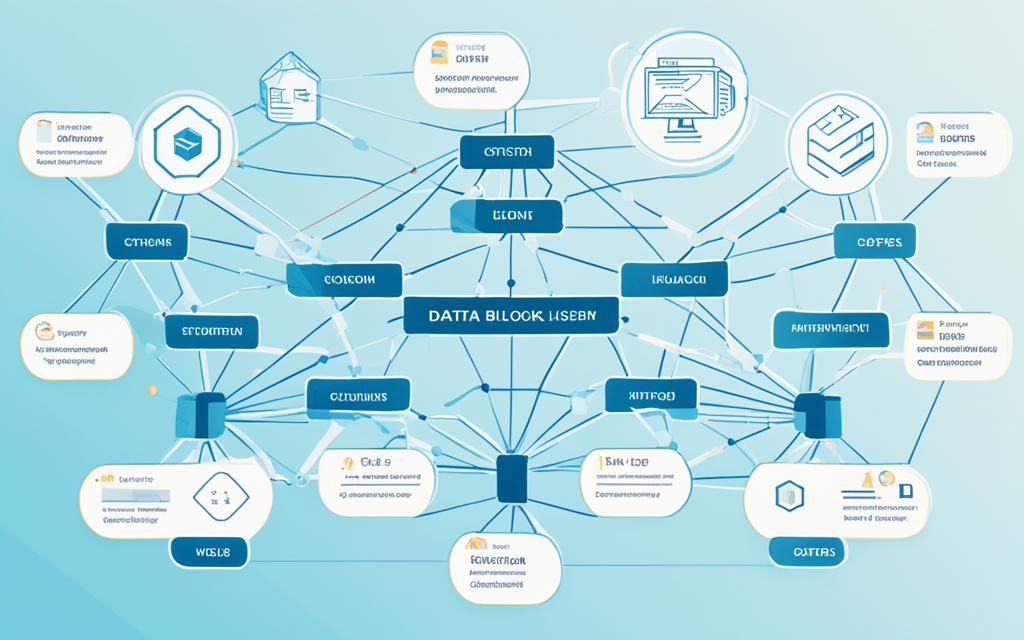Table of Contents
Data-sharing is key for today’s businesses, and blockchain makes it secure and transparent. It uses special methods like cryptography and distributed ledgers to keep data safe and open.
Blockchains come in different types, like those with limited access and others open to everyone1. Restricted blockchains let only approved people share data, while open ones allow anyone to join in1.
In areas such as tracking goods’ origins, blockchain’s use of distributed ledgers is vital1. It keeps extra copies of the data, making it harder to lose or change important information1.
When it comes to rules for sharing data, blockchain sets its own standards1. It supports direct sharing and data access through smart contracts, all done safely with the help of encryption and agreement methods12.
Blockchain also helps different networks talk to each other better1. This makes it easier for groups to work together and share data across borders1.
Key Takeaways:
- Data-sharing is crucial, and blockchain tech ensures it’s safe and clear.
- Blockchains vary from closed to open types, offering choices for data access.
- For following goods’ paths, blockchain’s use of detailed ledgers is a huge help1.
- It has its own ways to safely share data, focusing on secure practices1.
- Blockchain helps different networks interact well, allowing for smoother data sharing.
The Importance of Data Sharing for Organizations
Data sharing is vital for an organization’s success and growth. It helps them use data well. This makes collaboration, innovation, and smart decisions happen more.
Promoting Collaboration and Innovation
Sharing data encourages teamwork across teams and areas. It stops the isolation of data in pockets. This way, everyone can use more information for their jobs.
This sharing boosts fresh ideas. People can find patterns and spot new chances from various data. It helps teams work smoothly together, bringing all their skills and knowledge.
Looking at stats from link3, we see Bitcoin mining uses a lot of power. It shows we need to work together and be inventive. This way, we can mine more sustainably.
Driving Data-Driven Decision-Making
Making choices based on data is essential for success. By sharing data, organizations get a clear picture from all angles. They see trends and patterns to make smart decisions.
This sharing helps see risks and benefits clearly. It lets companies adjust fast to market shifts and come up with strong strategies. These strategies help them grow and win over rivals.
Stats from link4 show blockchain helps in healthcare. It ensures data accuracy and patient privacy. Such tech lets healthcare teams make the best decisions for their patients.
Sharing data within and outside an industry is beneficial. It fosters teamwork and leads to better results for everyone involved.
| The Benefits of Data Sharing for Organizations |
|---|
| 1. Enhanced collaboration and innovation |
| 2. Data-driven decision-making |
| 3. Improved operational efficiency |
| 4. Identifying new business opportunities |
Data sharing makes a company more dynamic. It helps them handle changes and find chances for growth.
Benefits of Data Sharing for Organizations
Data sharing is crucial for the success of today’s businesses. Through sharing data, companies can enjoy many gains. These include growth and long-term survival. Here are the main advantages:
1. Enhanced Data Security
In today’s digital world, keeping data safe is a top priority. Companies need to guard against cyber threats and keep unauthorized users out. Blockchain is one technology that stands out for its security. It spreads out data management across a network of computers. This makes it very secure and hard to change. Plus, with features like encryption, access control, and agreement systems, it ensures data moves safely. The unchangeable records kept in a blockchain also mean data stays pure and security gets stronger5.
2. Improved Transparency
Transparency builds trust between a company and those it works with. Using blockchain for data sharing makes everything open and unchangeable. This clear record of information transactions helps create trust. It also makes for better relationships with partners and customers. With data sharing, companies show they value honesty and fairness. This can give them an edge in their industry5.
3. Streamlined Data Management
Handling large amounts of data is hard work. Doing it manually takes a lot of time and can lead to errors. But, blockchain brings a way to make data management smoother. It uses smart contracts to automate tasks. These are agreements that work on their own, without the need for middlemen. This cuts down on paperwork, saving time and money. Plus, it makes sure data is handled accurately5.
4. Enhanced Data Traceability
Data tracking is vital in some fields, like ensuring food safety or managing healthcare information. Blockchain helps by creating records that can’t be changed. This gives full data traceability. In supply chains, it means being able to check a product’s path from start to finish. For healthcare, it improves drug tracking and keeps clinical study data open. This builds trust and ensures responsibility5.
5. Personalized and Enhanced Customer Experience
Data sharing enables businesses to better understand their customers. This allows for tailored service and product suggestions. By personalising their offers, companies exceed customer expectations. This approach boosts loyalty and satisfaction. Thus, it contributes to a company’s ongoing success5.
Data sharing has many benefits. It improves security, transparency, and management. It also makes traceability and customer care better. Thanks to blockchain, companies can explore new opportunities. They can also lead the way in their field.
| Benefits of Data Sharing for Organizations |
|---|
| Enhanced Data Security |
| Improved Transparency |
| Streamlined Data Management |
| Enhanced Data Traceability |
| Personalized and Enhanced Customer Experience |
How Blockchain Enhances Data Security
Blockchain tech boosts security using advanced crypto and agreement methods. It protects data’s honesty, privacy, and access, making it great for better safety for orgs.
Blockchain ensures data is real with unique digital fingerprints for each block6. Changing data changes the hash, showing someone’s been tampering. Blockchain’s open nature lets anyone check if data is safe by comparing these hashes.
Data is also kept secure through encryption6. It uses special codes to lock data so only the right people can open it. This includes checking the signatures to make sure the data is real, all adding to blockchain’s security6.
Its spread-out way of storing data helps as well. It means there’s no single weak spot to attack or corrupt. Plus, many computers have to agree on each change, stopping bad actors messing with info6.
Once something’s in the blockchain, it’s stuck there forever. This stops anyone from changing it secretly. It’s a great record of everything that’s happened, always staying safe from editing6.
With blockchain, orgs improve how they secure data. It beats central databases and old ways of sharing info hands-down. Blockchain is open, safe, and great for keeping secrets safe6.
Blockchain makes data safer with its smart codes, unbreakable checks, secret locks, and scattered storage. This way, organizations protect their secrets and trust their important data is safe and sound.
Enhancing Data Transparency with Blockchain
Blockchain technology is key in making data transparent. It does this by sharing data, tracing its path, and making people accountable for it. This allows information to travel easily, building trust and safety online.
One major perk of blockchain is how it spreads data. It uses networks without a central authority. This means everyone in the network can see the same data. This openness leads to instant updates and having info easily available for everyone, which boosts teamwork and better decisions7.
Tracking data through blockchain is also vital. It uses special codes to follow where data comes from and goes to. If any data is changed, it’s easy to see. This keeps the data reliable and stops anyone from changing it secretly7.
Blockchain also makes people responsible for the data. It uses digital signatures and smart contracts to let only certain people use the data. This keeps the data safe and clear who did what, cutting down on fraud7.
Blockchain has big pluses for whole sectors, not just one company. Famous market trends and experts like Morningstar and Harvard say it helps with climate issues and makes supply chains clear. By using it, companies can be seen as more honest, which makes both the environment and people happier7.
What’s more, Deloitte tells us blockchain works great with other new tech, like IoT and AI, to better supply chains further. All these together make things smoother, more efficient, and clear. This helps everyone to know what’s happening throughout the supply chain7.
Altogether, blockchain changes how we handle and see data in many parts of life. It helps build safe and clear systems that we can trust. These systems support honest work and working together well, which spurs on progress and new ideas in our digital world.

References:
- Deloitte: Supply Chain Blockchain
- Morningstar Sustainalytics
- Harvard Business Review
Case Studies of Organizations Using Blockchain for Data Sharing
Blockchain technology has become very popular in many fields. It helps change how we share data. Big companies now use blockchain to share information in a safe, open way. This proves how useful and beneficial blockchain can be.
IBM: IBM, a top tech company, uses blockchain in its supply chain. It creates a secure place for partners to share data. This way, IBM improves how they track products and make sure everything is true. It helps reduce cheating and make sure products are real [source].
UNICEF: The United Nations Children’s Fund (UNICEF) also uses blockchain. It tracks how they send out help to people. With blockchain, they can better show where aid goes. This makes help reach those who need it, quicker and with more honesty [source].
Walmart: Walmart is a big fan of blockchain too, for its food. It tracks where the food comes from and its quality. With this tech, Walmart makes sure food is safe, there’s less chance of harm, and gives customers clear details about what they buy [source].
These stories show how flexible and helpful blockchain is for sharing data well. Using blockchain can change how a business works, make everyone trust it more, and bring new ideas.
Case Studies Summary:
| Organization | Industry | Application | Benefits |
|---|---|---|---|
| IBM | Technology | Supply Chain | Enhanced traceability and transparency, reduced fraud |
| UNICEF | Humanitarian Aid | Aid Distribution | Improved transparency and accountability in aid delivery |
| Walmart | Retail | Product Traceability | Enhanced food safety and transparency for consumers |
These stories show how IBM, UNICEF, and Walmart are using blockchain. They make sharing data safe and clear. This boosts innovation and trust.8910
Ensuring Data Efficiency Using Blockchain
Blockchain technology has the power to make data work better. It makes use of a decentralized and clear system. This helps cut costs and makes things smoother. With this tech, businesses can do better with handling and sharing their data.
Technologies like Bitcoin, Ethereum, and Zcash are at the heart of this. Their rise has caught the eye of many, from experts to business leaders. They see how these techs can change the way we manage and keep data safe11. For many fields, like healthcare, money services, and keeping info safe, they say blockchain is the way to go11. It brings a new way to trust and keep data safe.
One big plus of using blockchain is that it cuts out middlemen. Usually, data goes through many people before getting where it needs to go11. This can slow things down and cost more. But with blockchain, things happen directly between the people involved. This makes everything faster and cheaper11.
Blockchain is also safe and changes are easy to spot. Research shows how to use special tech to keep data safe and real. It deals with who can get to the data and how11. Using blockchain’s way of not having a central point, places can keep their data super safe. This stops people from stealing it or changing it without permission.
There’s also a good way to look after who uses what data online. A plan by Zhang and Zhao suggests a smart way to track and share info. This way, everything about info use, how much it costs, and who can use it is clear11. This makes managing data easier and cuts down on extra work.
Blockchain also helps protect things like songs and ideas online. A system called DRMchain uses blockchain to stop people using your creative stuff without permission11. This keeps the creators in charge of their work while letting people see it in a safe way.
Encouraging people to share their data is key. In fields like medicine, we need smart ways to get people to share info. It helps with making new discoveries11. Yet, we still need more ideas on how to make people want to share. This is especially true in healthcare.
Blockchain can cut costs too, by getting rid of the need for middlemen. Also, it makes doing deals faster and easier. A plan called CBDM wants to make sure blockchain is safe to use, especially in the cloud11. This keeps things under control, saving money and resources.
The more we use digital data, the more space we need. This is why people rely more on cloud storage. But with blockchain, we can use our data better, needing less cloud. This saves a lot of money11.
In the end, blockchain is a big help in how we handle data. It makes things smoother, safer, and costs less. It’s a great step for how businesses and ideas work with data. Thanks to blockchain, we can think of new ways to grow and stay ahead in a world where data is key.
Benefits of Blockchain for Data Efficiency
| Benefits | Description |
|---|---|
| Streamlined processes | Blockchain gets rid of the middlemen, making things simpler and faster. |
| Data security | With its spread-out and hard-to-change design, blockchain keeps data safe and real. |
| Cost reduction | Getting rid of middlemen and cutting cloud use makes blockchain save money. |
| Incentive mechanisms | Ideas based on blockchain can make people want to share more, pushing research forward. |
Industries Benefiting from Blockchain Data-Sharing
Blockchain tech could change how we share data in many fields. It brings better security, clearness, and does things quicker. Let’s look at how each industry can use blockchain to its advantage.
1. Healthcare
Healthcare is excited about blockchain for keeping data safe and being easy to use together. It helps keep patient info safe while being shared with doctors, insurers, and researchers. This tech also makes medical records better, keeps track of drugs, and shares clinical trial data safely. All this makes healthcare better for patients and more efficient12.
2. Supply Chain and Logistics
In moving goods around, blockchain makes every step clear and trustworthy. It tracks every change in ownership. This makes sure everyone knows where goods are, fights fake products, and cuts wasted time. It makes the supply chain more trustable, smoother, and tougher against problems12.
3. Finance and Banking
Blockchain could really shake up finance by making paying across borders easier and cheaper. It cuts out the middleman to allow direct payments. It also helps with verifying who you are, fights fraud, and makes trading smoother. Using blockchain, banks can be more efficient, follow rules better, and give customers a smoother experience13.
4. Real Estate
In house selling, blockchain helps with truth, trust, and safety. It makes signing deals or changing ownership online safe and sure. This is thanks to smart contracts. Using blockchain, buying and selling homes becomes cheaper, safer, and clear for everyone12.
5. Intellectual Property
Creating and protecting ideas gets a lot easier and more verified with blockchain. It makes a clear, unchangeable record of owning ideas. This stops others from using them without permission and makes paying for their use easier. It helps anyone who invents or creates, keep their ideas safe14.
6. Energy and Utilities
As we use more green power, blockchain can help manage this better. It makes it easier to sell energy between people and ensures only genuine green energy gets recognition. This tech turns energy into a big online market, which encourages using more green power and uses energy smarter14.
7. Government and Public Services
For governments, using blockchain can make things clearer, less corrupt, and more trusted by the people. It can help with IDs, voting, and keeping public info safe. With blockchain, public services become more efficient, cut waste, and make things easier for everyone13.
The use of blockchain is growing fast in all sorts of areas. From health to finance, real estate to government services, it’s bringing big changes. By joining in, these industries can do things more safely, clearly, and quickly. It’s all about using new tech to make our lives better.
Challenges and Future Trends in Blockchain Data Sharing
Blockchain has transformed how we share data, offering secure and clear transactions. Yet, its use comes with hurdles that companies must overcome. This is key for a smooth incorporation.
Technical Challenges
- Scalability can become an issue as more join blockchain networks. It becomes harder to keep up efficient performance with a high volume of transactions.
- The tricky part is balancing transparency with privacy, more so in public blockchains.
- Interoperability is crucial for data sharing among various blockchain types.
To tackle these issues, ongoing research and development are essential for improving system scalability, privacy, and interoperability15.
Organizational Challenges
- Some might resist switching to blockchain, from both within and outside the company. Managing this resistance well is vital.
- Merging blockchain with the current setup requires detailed planning for a seamless shift.
Overcoming these challenges is about fostering innovation, educating everyone involved, and using step-by-step integration methods15.
Regulatory Challenges
- Staying compliant with data protection laws is essential. This means dealing with complex regulations.
- The balancing act between blockchain transparency and privacy laws raises significant legal and regulatory hurdles.
To meet these challenges, staying up-to-date with regulations and engaging legal advice are key15.
Future Trends
While not without challenges, blockchain data sharing is advancing, leading to new trends.
- Hybrid blockchains, mixing public and private networks, are emerging as a versatile solution.
- AI’s fusion with blockchain can boost analysis, decision-making, and automation.
These emerging trends highlight how hybrid blockchains and AI could redefine blockchain data sharing’s future. They promise improved security and efficiency15.
In the end, despite challenges, blockchain technology offers vast prospects for secure, clear data sharing. To reap its full benefits, companies must deal with technical, organizational, and regulatory hindrances. By looking forward to trends like hybrid blockchains and AI, organizations can boost efficiency and find new paths in data sharing.
Conclusion
Blockchain has changed the game in how companies handle sharing data. It makes data sharing more secure, private, and accountable. Many companies in the same industry are moving to blockchain for these benefits and the anonymity it offers16. Sectors like audio/video streaming, healthcare, and social media are turning to blockchain because it cuts down on sharing data costs16.
Compared to Web 2.0, blockchain is much better when it comes to keeping data safe and private16. Web 2.0 uses central databases to move data quickly, but blockchain’s decentralized method in Web 3 boosts security and privacy16. Though there are challenges, like its technical complexity, developers are working hard to solve them16. Companies are finding ways to mix blockchain and traditional sharing methods to overcome issues and improve how they share data16.
Case studies show blockchain works well in managing supplies, e-voting, and global KYC chains. This proves its value in different areas16. The future of blockchain sharing data seems bright. With new trends like mixing blockchains and using AI, data sharing will only get safer and more efficient. Companies that make the most of blockchain’s potential can lead in the competitive world of data today.
FAQ
What is data-sharing in blockchain systems?
Data-sharing in blockchain systems is about securely and transparently sharing data. Blockchain uses advanced technology for safety, trust, and open access to data. It keeps information safe with special codes, agreement methods, and digital records.
Why is data sharing important for organizations?
Data sharing helps organisations work together better and make smarter choices. It lets them find important data easily, work well with others, come up with new plans, and do tasks better.
What are the benefits of data sharing for organizations?
Data sharing has many perks for organisations. It makes data safer by keeping it secure and only accessible to the right people. It makes it clearer who does what with the data, through a shared digital record. Data sharing helps to copy tasks in a stronger and faster way through smart deals. Keeping track of data moves over time, helps ensure its trust. Offering detailed data insights can improve how customers are treated.
How does blockchain enhance data security?
Blockchain makes data safer using secret codes and checks. These codes make sure data is real and can be checked by anyone. Checks on data happening are verified by the team. It also hides the data away from those who shouldn’t see it, using lock-and-key methods.
How does blockchain enhance data transparency?
Blockchain opens up who gets to see and work with data using clear paths. No middlemen are needed, and everyone sees the same facts. Tracking shows where the data started and how it’s changed. Digital signs and deals mean only the right people can touch the data.
Can you provide some case studies of organizations using blockchain for data sharing?
Yes. Many groups use blockchain to share data safely and clearly. IBM uses it in trading to safely share information. UNICEF checks aid delivery is right with blockchain. Walmart sees where food starts with blockchain.
How does blockchain ensure data efficiency?
Blockchain cuts down on who needs to handle data and speeds up how it moves. This makes sharing and sorting data quicker and easier. It means fewer mistakes and tasks get done faster.
What industries can benefit from blockchain data-sharing?
Many areas could do better with blockchain for data. Healthcare gets safer and easier to share information. Trade sees where things start and cuts cheating and waste. Banks send money safer and faster, and trading papers are simpler. Homes, ideas, power, and public services can also share data simpler and safer.
What are the challenges and future trends in blockchain data sharing?
Some face slow growth, privacy worries, working well together, and not wanting change. The mix of public and private networks is new and AI helps look at data better and choose more wisely.
How does blockchain revolutionize data sharing?
Blockchain makes data sharing safe, clear, and fast for groups. It keeps data safe, true and clear. Cases show how groups improve with using blockchain to share data well.
Source Links
- https://blockchainreporter.net/which-statement-describes-data-sharing-in-a-blockchain/ – Which Statement Describes Data-Sharing In a Blockchain
- https://www.ibm.com/topics/blockchain – What Is Blockchain? | IBM
- https://www.investopedia.com/terms/b/blockchain.asp – Blockchain Facts: What Is It, How It Works, and How It Can Be Used
- https://www.ncbi.nlm.nih.gov/pmc/articles/PMC7917907/ – A Blockchain-Based Secret-Data Sharing Framework for Personal Health Records in Emergency Condition
- https://atomyze.us/solving-the-mysteries-the-blockchains-data-sharing-mechanism/ – Which Statement Describes Data Sharing In A Blockchain? Beyond the Hype
- https://builtin.com/blockchain – Blockchain: What It Is, How It Works, Why It Matters
- https://www2.deloitte.com/us/en/pages/operations/articles/blockchain-supply-chain-innovation.html – Using Blockchain to Drive Supply Chain Transparency and Innovation
- https://www.mckinsey.com/capabilities/mckinsey-digital/our-insights/using-blockchain-to-improve-data-management-in-the-public-sector – Using blockchain to improve data management in the public sector
- https://www.ncbi.nlm.nih.gov/pmc/articles/PMC9859363/ – Sharing Health Information Using a Blockchain
- https://www.frontiersin.org/articles/10.3389/fbloc.2020.497985 – A Blockchain Platform for User Data Sharing Ensuring User Control and Incentives
- https://www.mdpi.com/2071-1050/11/24/7054 – A Secure Data Sharing Platform Using Blockchain and Interplanetary File System
- https://widgets.weforum.org/blockchain-toolkit/data-integrity/index.html – WEF Blockchain Toolkit
- https://en.wikipedia.org/wiki/Blockchain – Blockchain
- https://www.himss.org/resources/blockchain-healthcare – Blockchain in Healthcare
- https://link.springer.com/article/10.1007/s12083-021-01127-0 – Blockchain smart contracts: Applications, challenges, and future trends – Peer-to-Peer Networking and Applications
- https://geekyants.com/blog/how-can-blockchain-technology-help-businesses-share-data – How Can Blockchain Technology Help Businesses Share Data?








